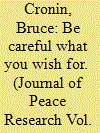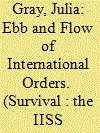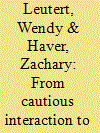| Srl | Item |
| 1 |
ID:
101696


|
|
|
|
|
| Publication |
2010.
|
| Summary/Abstract |
Most theories that seek to explain the relationship between major war and the creation of new political orders posit a direct link between the interests of the winning states and the type of order that emerges. We tend to assume that since most wars are fought for specific purposes and a defined goal, the aftermath of the conflict will reflect the interests and preferences of the winning parties. This article challenges this approach, arguing that the necessity of securing public support and winning allies forces states to make public commitments for a postwar reconstruction that they might otherwise avoid. During the course of the war, states unintentionally limit their options for the postwar reconstruction by publicly articulating a set of 'war aims' that are designed to rally public support and win over potential allies. Since war aims are as much statements of propaganda as of policy they often do not reflect the state interest per se. However, once articulated, they become the official policy of the coalition, and political leaders are forced to implement their principles as the foundation for the new order.
|
|
|
|
|
|
|
|
|
|
|
|
|
|
|
|
| 2 |
ID:
155492


|
|
|
|
|
| Summary/Abstract |
Mindful of the growing interest in non-Western and pre-modern political systems, we propose a framework for the analysis of states, state systems, and international orders. We provide a culturally neutral definition of the state and outline a method for assessing variation in political organization both within and above the state. Our framework cleanly delineates hierarchy from anarchy and can be applied to a diverse set of state systems. We then show how the content of international order inter-relates with system structure and the local density (interaction capacity) of a region. We argue that our framework captures similarities—and exposes differences—between different systems and orders over time and space. It strikes a balance between the traditional focus on the Western experience and the current trend toward regional studies in which it is difficult to accumulate knowledge in a rigorous manner.
|
|
|
|
|
|
|
|
|
|
|
|
|
|
|
|
| 3 |
ID:
164541


|
|
|
|
|
| Summary/Abstract |
For every successful international organisation, many others died out or never got off the ground.
|
|
|
|
|
|
|
|
|
|
|
|
|
|
|
|
| 4 |
ID:
170996


|
|
|
|
|
| Summary/Abstract |
As the Belt and Road Initiative expands the global footprint of Chinese firms, Beijing increasingly relies on international law to protect investments overseas. How and why has China's engagement with the international investment regime evolved over the past four decades? This article addresses these questions by examining the central component of the international investment regime: bilateral investment treaties (BITs). Through analyzing China's BIT practice and the security exceptions in 1,173 BITs concluded by both China as well as its treaty partners, this article provides evidence of changing Chinese engagement, from cautious interaction (1978–1991) to active participation (1992–1997), committed implementation (1998–2012), and mature influence (2013–present). As Beijing accepted, applied, and shaped the rules and norms of the BIT system, China's treaty practice co-evolved with the international investment regime. A co-evolutionary approach illuminates why—and how—state behaviour and international orders change over time.
|
|
|
|
|
|
|
|
|
|
|
|
|
|
|
|
| 5 |
ID:
180369


|
|
|
|
|
| Summary/Abstract |
If it continues, deglobalization may lead not to atomization but two overlapping international orders: a liberal one (LIO) led by the United States, and an authoritarian–capitalist one (ACIO) led by China. This equilibrium could emerge because a central purpose of international orders is to preserve the domestic regimes of their Great Power sponsors. The United States and China have markedly different domestic regimes, and so as China continues to grow in power and influence, tension over the content of international order should continue to grow. I borrow from Darwinian evolution the notion of ‘niche construction’: just as organisms alter phenotype selection by manipulating their natural environments, states can alter the ‘selection’ of domestic regimes by shaping their international environments. Modes of international niche construction include foreign regime promotion, interdependence, transnational interaction and multilateral institutions. The liberal democratic niche constructed by the United States and its allies after the Second World War preserved democracy for many decades. Today, China is attempting through various means to build a niche that will eliminate the liberal bias in international institutions and safeguard its own Market-Leninist regime. The resulting ACIO would select for autocracy and hence be partially separate from the LIO, which selects for liberal democracy.
|
|
|
|
|
|
|
|
|
|
|
|
|
|
|
|